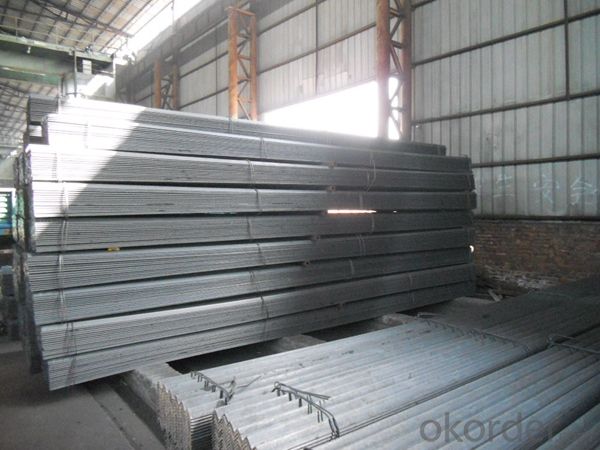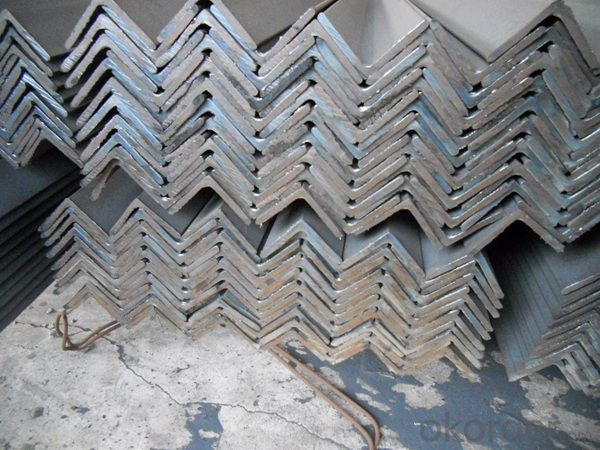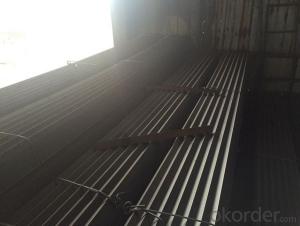Hot Rolled JIS Standard Equal Angle Steel Bars for Construction, Structu
- Loading Port:
- Tianjin
- Payment Terms:
- TT OR LC
- Min Order Qty:
- 25 m.t.
- Supply Capability:
- 200000 m.t./month
OKorder Service Pledge
OKorder Financial Service
You Might Also Like
Product Description:
OKorder is offering Hot Rolled JIS Standard Equal Angle Steel Bars for Construction, Structure at great prices with worldwide shipping. Our supplier is a world-class manufacturer of steel, with our products utilized the world over. OKorder annually supplies products to European, North American and Asian markets. We provide quotations within 24 hours of receiving an inquiry and guarantee competitive prices.
Product Applications:
Hot Rolled JIS Standard Equal Angle Steel Bars for Construction, Structure are ideal for structural applications and are widely used in the construction of buildings and bridges, and the manufacturing, petrochemical, and transportation industries.
1. Supporting members, most commonly in the house raising industry to strengthen timber bears under houses. Transmission line towers, etc
2. Prefabricated structure
3. Medium scale bridges
4. It is widely used in various building structures and engineering structures such as roof beams, bridges, transmission towers, hoisting machinery and transport machinery, ships, industrial furnaces, reaction tower, container frame and warehouse etc.
Product Advantages:
Hot Rolled JIS Standard Equal Angle Steel Bars for Construction, Structure are durable, strong, and resist corrosion.
Main Product Features:
· Premium quality
· Prompt delivery & seaworthy packing (30 days after receiving deposit)
· Corrosion resistance
· Can be recycled and reused
· Mill test certification
· Professional Service
· Competitive pricing
Product Specifications:
.Standards:GB,ASTM,BS,AISI,DIN,JIS
2.Invoicing on theoretical weight or actual weight as customer request
3.Material: JIS G3192,SS400;SS540.
4. Payment terms:
1).100% irrevocable L/C at sight.
2).30% T/T prepaid and the balance against the copy of B/L.
3).30% T/T prepaid and the balance against L/C
5.Sizes:

EQUAL ANGLES SIZES | |||
a(mm) | a1(mm) | thickness(mm) | length |
25 | 25 | 2.5---3.0 | 6M/12M |
30 | 30 | 2.5---4.0 | 6M/12M |
38 | 38 | 2.5 | 6M/12M |
38 | 38 | 3.0---5.0 | 6M/12M |
40 | 40 | 3.0---6.0 | 6M/12M |
50 | 50 | 3 | 6M/12M |
50 | 50 | 3.7---6.0 | 6M/9M/12M |
60 | 60 | 5.0---6.0 | 6M/9M/12M |
63 | 63 | 6.0---8.0 | 6M/9M/12M |
65 | 65 | 5.0---8.0 | 6M/9M/12M |
70 | 70 | 6.0---7.0 | 6M/9M/12M |
75 | 75 | 5.0---10.0 | 6M/9M/12M |
80 | 80 | 6.0---10.0 | 6M/9M/12M |
90 | 90 | 6.0---10.0 | 6M/9M/12M |
100 | 100 | 6.0---12.0 | 6M/9M/12M |
120 | 120 | 8.0-12.0 | 6M/9M/12M |
125 | 125 | 8.0---12.0 | 6M/9M/12M |
130 | 130 | 9.0-12.0 | 6M/9M/12M |
140 | 140 | 10.0-16.0 | 6M/9M/12M |
150 | 150 | 10---15 | 6M/9M/12M |
160 | 160 | 10---16 | 6M/9M/12M |
180 | 180 | 12---18 | 6M/9M/12M |
200 | 200 | 14---20 | 6M/9M/12M |
5. Material Specifications:
Grade | Yield Strength,N/mm² | Extension Strength N/mm² | |||
Thickness of Steel,mm | |||||
≦16 | >16-≦40 | >40-≦100 | >100 | ||
SS330 | ≧205 | ≧195 | ≧175 | ≧165 | 330-430 |
SS400 | ≧245 | ≧235 | ≧215 | ≧205 | 400-510 |
SS490 | ≧285 | ≧275 | ≧255 | ≧245 | 490-610 |
SS540 | ≧400 | ≧390 | - | - | ≧540 |
FAQ:
Q1: Why buy Materials & Equipment from OKorder.com?
A1: All products offered byOKorder.com are carefully selected from China's most reliable manufacturing enterprises. Through its ISO certifications, OKorder.com adheres to the highest standards and a commitment to supply chain safety and customer satisfaction.
Q2: How do we guarantee the quality of our products?
A2: We have established an advanced quality management system which conducts strict quality tests at every step, from raw materials to the final product. At the same time, we provide extensive follow-up service assurances as required.
Q3: How soon can we receive the product after purchase?
A3: Within three days of placing an order, we will begin production. The specific shipping date is dependent upon international and government factors, but is typically 7 to 10 workdays.
Q4: What makes stainless steel stainless?
A4: Stainless steel must contain at least 10.5 % chromium. It is this element that reacts with the oxygen in the air to form a complex chrome-oxide surface layer that is invisible but strong enough to prevent further oxygen from "staining" (rusting) the surface. Higher levels of chromium and the addition of other alloying elements such as nickel and molybdenum enhance this surface layer and improve the corrosion resistance of the stainless material.
Q5: Can stainless steel rust?
A5: Stainless does not "rust" as you think of regular steel rusting with a red oxide on the surface that flakes off. If you see red rust it is probably due to some iron particles that have contaminated the surface of the stainless steel and it is these iron particles that are rusting. Look at the source of the rusting and see if you can remove it from the surface.


- Q:How are steel angles tested for quality and strength?
- Steel angles are tested for quality and strength through various methods to ensure they meet the required standards and specifications. One of the primary tests conducted on steel angles is the tensile test, which measures the material's resistance to breaking under tension. This test involves applying a gradually increasing load to a sample of the steel angle until it reaches its breaking point. The maximum load the angle can withstand is measured, and this provides critical information about its tensile strength. Another important test is the hardness test, which determines the steel angle's resistance to indentation. This test helps to assess the material's ability to withstand wear and tear, as well as its overall strength. Hardness is typically measured using the Rockwell or Brinell scales, where a harder material indicates higher strength. To ensure the steel angle's quality, it also undergoes visual inspections for any surface defects, such as cracks, uneven surfaces, or deformities. These inspections are conducted by trained professionals who carefully examine the angles for any imperfections that may compromise their structural integrity. In addition to these tests, steel angles may also undergo chemical composition analysis to verify that the material meets the required specifications. This analysis determines the percentage of various elements present in the steel, such as carbon, manganese, and sulfur, which directly impact the angle's strength and durability. Overall, steel angles are rigorously tested for quality and strength through a combination of physical, visual, and chemical tests. These tests ensure that the angles can withstand the intended loads and perform safely in various applications, providing confidence in their reliability and longevity.
- Q:Can steel angles be used as supports for mechanical or HVAC ducts?
- Yes, steel angles can be used as supports for mechanical or HVAC ducts. Steel angles provide a strong and durable framework to securely hold and provide stability to the ductwork.
- Q:What are the design considerations when using steel angles?
- When incorporating steel angles into design, there are several important factors to keep in mind. Firstly, the load-bearing capacity of the steel angles must be thoroughly evaluated. The anticipated loads and stresses that the structure will endure should dictate the selection of the appropriate size, thickness, and configuration of the angles. Another factor to consider is the structural integrity of the connections between the steel angles and other design elements. The connections must be designed to provide sufficient strength and stiffness, while also accommodating any potential movement or deformation of the angles. The potential for corrosion when using steel angles should also be taken into account. To prevent rust and deterioration, it is essential to apply suitable protective coatings or treatments, especially in outdoor or high-moisture environments. Aesthetics and visual appeal are also significant considerations in design. The shape, finish, and overall appearance of the steel angles should align with the desired aesthetic of the project, whether it is a modern, industrial look or a more traditional and ornamental design. Finally, cost and availability should be considered when incorporating steel angles. The project's overall budget should be weighed against the cost of materials, fabrication, and installation. Additionally, it is important to consider the availability of the desired sizes and configurations of steel angles to ensure a smooth and timely construction process. By carefully considering these design factors, designers can effectively integrate steel angles into their projects, guaranteeing structural integrity, aesthetic appeal, and cost-effectiveness.
- Q:Can steel angles be used in architectural sculptures and installations?
- Yes, steel angles can be used in architectural sculptures and installations. Steel angles are versatile and commonly used in construction due to their strength and durability. They can be easily welded, bolted, or attached using other methods, making them ideal for creating intricate and complex structures. Steel angles can be shaped and formed into various angles and curves, allowing for creative and unique designs in architectural sculptures and installations. Additionally, steel angles can be finished with different coatings or paints to enhance their aesthetic appeal and protect them from corrosion, making them a suitable choice for both indoor and outdoor installations. Overall, steel angles offer the necessary strength, flexibility, and aesthetic possibilities required for architectural sculptures and installations.
- Q:What are the design considerations for using steel angles in construction?
- When it comes to incorporating steel angles in construction, there are various factors that need to be taken into account. To begin with, the load-bearing capacity of the steel angles plays a vital role. Careful selection of the angle's size and thickness is necessary to ensure that it can adequately support the expected loads and stresses imposed on the structure. This involves considering factors like the weight of the structure, live loads, wind loads, and seismic forces. Another crucial aspect to consider is the connection details. Typically, steel angles are joined together using bolts, welds, or a combination of both. It is imperative to engineer these connections meticulously to ensure effective load transfer between the angles and other structural components, such as beams or columns. Moreover, the connection details should also account for potential movement or expansion of the structure in order to prevent any failure or damage. Furthermore, the potential for corrosion must be taken into consideration during the design phase. Over time, steel angles can corrode when exposed to moisture or aggressive environments. Thus, it is essential to consider appropriate protective measures, such as coatings or galvanization, to enhance the durability and lifespan of the structure. In addition to the technical aspects, the aesthetics and architectural requirements of the project should also be given due thought. Steel angles can be utilized not only for their structural properties but also for their visual appeal. Therefore, the design should consider the desired appearance, including the shape, size, and placement of the angles, to ensure they align with the overall design intent of the structure. Lastly, the cost and availability of steel angles should not be overlooked. The design should aim to optimize the use of steel angles in order to minimize material waste and fabrication costs. It is advisable to select standard sizes and shapes that are readily available in the market, as this can reduce lead times and costs associated with custom fabrication. In conclusion, the design considerations for incorporating steel angles in construction encompass load-bearing capacity, connection details, corrosion protection, aesthetics, and cost. By meticulously considering these factors, engineers and architects can effectively integrate steel angles into the design, resulting in a safe, durable, and visually pleasing structure.
- Q:Can steel angles be used for framing or supporting exterior cladding systems?
- Yes, steel angles can be used for framing or supporting exterior cladding systems. Steel angles provide structural support and stability, making them suitable for this purpose. They can be used to create a framework or support structure for exterior cladding systems, ensuring durability and architectural integrity.
- Q:Can steel angles be used in bridges or elevated walkways?
- Bridges and elevated walkways can indeed utilize steel angles. Construction projects often employ steel angles because of their strength and versatility. These angles offer structural support and stability, making them perfect for applications like bridges and elevated walkways. By utilizing steel angles, one can establish a framework and support system that guarantees durability and safety for these structures. Furthermore, the ease of welding or bolting steel angles together enables efficient installation and maintenance. In conclusion, the construction of bridges and elevated walkways frequently leans towards steel angles due to their strength, dependability, and user-friendly nature.
- Q:Can steel angles be used in the construction of industrial chimneys?
- Yes, steel angles can be used in the construction of industrial chimneys. Steel angles provide structural support and stability to the chimney, making them a common choice in industrial construction projects.
- Q:What is the typical tolerance for steel angles?
- The specific application and industry standards determine the typical tolerance for steel angles. Generally, the industry standard allows for a tolerance of ±1/8 inch or ±3 millimeters. This means that the actual dimensions of the angle can differ by up to 1/8 inch or 3 millimeters from the specified dimensions. It is worth noting that these tolerances may differ depending on the grade of steel and the manufacturing process used. Consequently, it is vital to refer to the appropriate industry standards or specifications for the specific project in order to ascertain the precise tolerance requirements for steel angles in that particular application.
- Q:How do steel angles perform under high temperatures?
- Steel angles perform well under high temperatures due to their high melting point and excellent heat resistance. Steel is a widely used material in construction and engineering, known for its structural strength and durability. When exposed to high temperatures, steel angles retain their structural integrity and do not deform or weaken easily. This is because steel has a high melting point, typically around 1370 to 1530 degrees Celsius (2500 to 2800 degrees Fahrenheit), which allows it to withstand extreme heat without significant damage. Additionally, steel has excellent heat resistance, meaning it can dissipate heat efficiently and maintain its stability under high thermal loads. This makes steel angles suitable for applications where elevated temperatures are present, such as in industrial furnaces, power plants, or high-temperature environments. However, it is important to note that the specific performance of steel angles under high temperatures may vary depending on the grade and composition of the steel, as well as the duration and intensity of the heat exposure.
1. Manufacturer Overview |
|
|---|---|
| Location | |
| Year Established | |
| Annual Output Value | |
| Main Markets | |
| Company Certifications | |
2. Manufacturer Certificates |
|
|---|---|
| a) Certification Name | |
| Range | |
| Reference | |
| Validity Period | |
3. Manufacturer Capability |
|
|---|---|
| a)Trade Capacity | |
| Nearest Port | |
| Export Percentage | |
| No.of Employees in Trade Department | |
| Language Spoken: | |
| b)Factory Information | |
| Factory Size: | |
| No. of Production Lines | |
| Contract Manufacturing | |
| Product Price Range | |
Send your message to us
Hot Rolled JIS Standard Equal Angle Steel Bars for Construction, Structu
- Loading Port:
- Tianjin
- Payment Terms:
- TT OR LC
- Min Order Qty:
- 25 m.t.
- Supply Capability:
- 200000 m.t./month
OKorder Service Pledge
OKorder Financial Service
Similar products
New products
Hot products
Related keywords




























